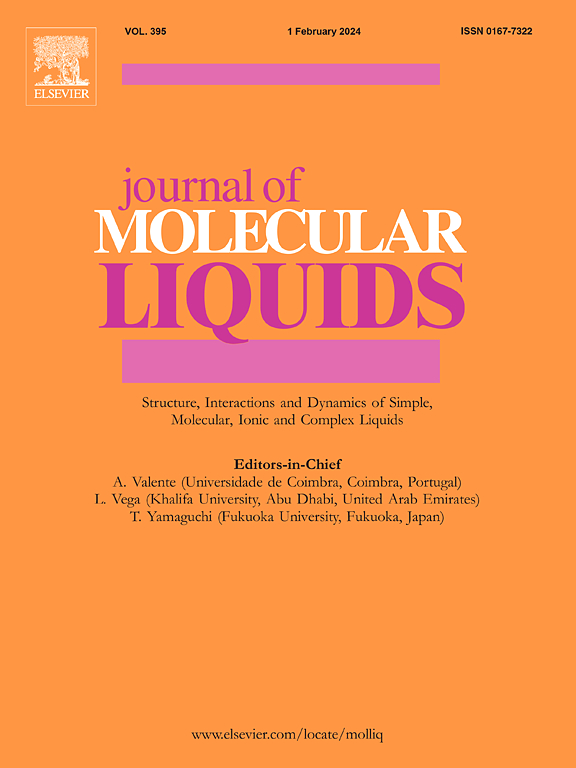Coupled influence of thermo diffusion and Brownian motion on bioconvection in Prandtl nanofluids across curved geometries
IF 5.3
2区 化学
Q2 CHEMISTRY, PHYSICAL
引用次数: 0
Abstract
This paper explores the innovative synergy between magnetohydrodynamics (MHD) and bioconvection in the flow dynamics of Prandtl nanofluids over curved surfaces. By introducing these coupled phenomena, the study uncovers a new realm of heat and mass transfer enhancement mechanisms that are uniquely applicable to advanced thermal systems. Curved interfaces play a pivotal role in the dynamics of nanofluid flow, particularly in systems where non-planar geometries are inherent, such as biological membranes, microchannel networks, or industrial heat exchangers. Partial differential equations numerically represent the study considering the curved surface's deformation vortices. The shooting method and the fourth-order Runge-Kutta approach are used to numerically solve the governing equations once they have been converted into ordinary differential equations via similarity transformations. MATLAB simulations are then utilized to evaluate the temperature, concentration, velocity, and bioconvective fields. The influence of MHD modifies fluid flow and heat distribution by the induced magnetic field, leading to alterations in the velocity profile and thermal boundary layer, ultimately enhancing heat dissipation efficiency. Simultaneously, bioconvection driven by buoyancy forces within the fluid medium creates intricate particle movements that redistribute the concentration of nanoparticles, directly influencing the system's thermal conductivity. Therefore, the study demonstrates that a synergistic increase in thermo diffusion and Brownian motion parameters leads to a peak enhancement of heat and mass transfer rates by up to 38 % and 42 %, respectively, compared to the flat plate scenario. In addition, higher Peclet numbers and microorganism density are found to amplify bioconvective cell accumulation near the surface, thickening the microorganism concentration layer.
热扩散和布朗运动对普朗特纳米流体中生物对流的耦合影响
本文探讨了磁流体力学(MHD)和生物对流在普朗特纳米流体在曲面上的流动动力学中的创新协同作用。通过引入这些耦合现象,该研究揭示了一个新的传热和传质增强机制领域,该机制独特地适用于先进的热系统。曲面界面在纳米流体流动动力学中起着关键作用,特别是在非平面几何结构固有的系统中,如生物膜、微通道网络或工业热交换器。考虑曲面变形涡的偏微分方程的数值表示。将控制方程通过相似变换转化为常微分方程后,采用射击法和四阶龙格-库塔法对其进行数值求解。然后利用MATLAB仿真来评估温度、浓度、速度和生物对流场。MHD的影响通过感应磁场改变流体的流动和热分布,导致速度剖面和热边界层的改变,最终提高了散热效率。同时,流体介质中浮力驱动的生物对流产生了复杂的颗粒运动,重新分配了纳米颗粒的浓度,直接影响了系统的导热性。因此,该研究表明,与平板情况相比,热扩散和布朗运动参数的协同增加导致传热和传质率的峰值增强分别高达38%和42%。此外,较高的Peclet数和微生物密度会放大表面附近的生物对流细胞积聚,使微生物浓度层变厚。
本文章由计算机程序翻译,如有差异,请以英文原文为准。
求助全文
约1分钟内获得全文
求助全文
来源期刊

Journal of Molecular Liquids
化学-物理:原子、分子和化学物理
CiteScore
10.30
自引率
16.70%
发文量
2597
审稿时长
78 days
期刊介绍:
The journal includes papers in the following areas:
– Simple organic liquids and mixtures
– Ionic liquids
– Surfactant solutions (including micelles and vesicles) and liquid interfaces
– Colloidal solutions and nanoparticles
– Thermotropic and lyotropic liquid crystals
– Ferrofluids
– Water, aqueous solutions and other hydrogen-bonded liquids
– Lubricants, polymer solutions and melts
– Molten metals and salts
– Phase transitions and critical phenomena in liquids and confined fluids
– Self assembly in complex liquids.– Biomolecules in solution
The emphasis is on the molecular (or microscopic) understanding of particular liquids or liquid systems, especially concerning structure, dynamics and intermolecular forces. The experimental techniques used may include:
– Conventional spectroscopy (mid-IR and far-IR, Raman, NMR, etc.)
– Non-linear optics and time resolved spectroscopy (psec, fsec, asec, ISRS, etc.)
– Light scattering (Rayleigh, Brillouin, PCS, etc.)
– Dielectric relaxation
– X-ray and neutron scattering and diffraction.
Experimental studies, computer simulations (MD or MC) and analytical theory will be considered for publication; papers just reporting experimental results that do not contribute to the understanding of the fundamentals of molecular and ionic liquids will not be accepted. Only papers of a non-routine nature and advancing the field will be considered for publication.
 求助内容:
求助内容: 应助结果提醒方式:
应助结果提醒方式:


